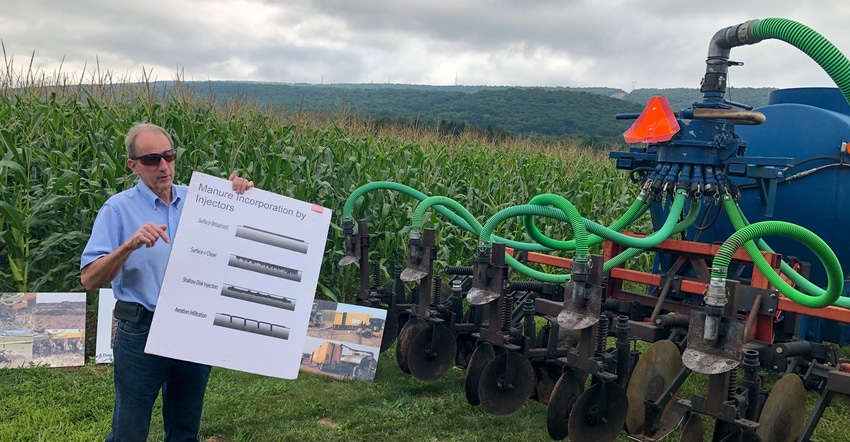
Surface-applied is still the preferred way for most farmers to apply manure to fields. The equipment for surface application is readily available and it can be done quickly, especially if you have short-term manure storage.
But there are disadvantages to surface applying — odors, nutrient loss, cost — that make alternatives such as shallow-disk injection a more attractive option. At the end of the day, though, it must benefit a farmer’s bottom line, among other things.
In long-term no-till, shallow disc injection might seem like a bad idea on the surface, according to Leon Ressler, agronomy educator at Penn State Extension. But technology and machine upgrades have caught up with what today’s farmers are doing.
He remembers 30 years ago when the push to reduce phosphorus runoff into local waterways was directly tied to decreasing soil erosion. Practices such as contour farming and no-till were adopted, and the no-till equipment got so good that you almost had to get down on your knees to see if any soil penetration occurred at planting.
“The same thing has happened with these shallow-disk injectors,” he says.
Phosphorus buildup
Ressler, who spoke recently at Ag Progress Days, says that researchers used to think that phosphorus didn’t dissolve in surface water in no-till because of the amount of soil erosion that was reduced.
But many years of manure application can leave a field with a highly concentrated band of phosphorus in the top inch or two, he says, and that band eventually dissolves and runs off in clear water.
Conventional tillage can mix the manure within the soil, but that goes against the principle of no-till in the first place.
Advances in injection
Today’s manure injectors can inject manure 3 or 4 inches below the surface with minimal soil disturbance, he says.
Injectors can also help reduce odors, an important factor in areas with urban encroachment.
In a study completed last December, Ressler and other researchers compared levels of dissolved phosphorus in surface and subsurface runoff (water that goes through the soil and collects in lysimeters) from broadcast and injected manure sites.
In the broadcast manure plots, an average of 1 milligram of phosphorus per liter was lost. In the injected manure plots, about six-tenths of a milligram of phosphorus per liter was lost, a 40% reduction.
“There is a major reduction in phosphorus loss by moving that manure off the surface," he says.
But you are technically disturbing the soil with the injection equipment.
So, in the same study, researchers looked at loss of grams of sediment per liter in both systems. In the broadcast system, 0.4 grams of sediment per liter were lost. In the injection system, 0.47 grams of sediment per liter were lost.
The injection system lost more sediment, but. “Statistically, it is not much of a difference. Basically, what it’s telling you is it is working and we’re not losing a lot,” he says.
Making it pay
Doing a farm research study has to relate to what farmers are doing on their own operation.
So, the researchers calculated the effects of surface-applied vs injected manure on silage corn production on a dairy farm in Morgantown.
Plots were replicated five times across a field and no nitrogen was applied.
Ressler says that in the incorporated manure plots the researchers got 2.6 tons per acre of additional silage. He says that the increase in production was enough to pay for the farmer’s 18-acre plot and that the farmer was pleased with what he saw.
Manure injection can also save on nitrogen loss, especially within the first hour of application.
“You are saving a little bit if you till within an hour,” he says of surface applied. “But most of it is already lost.”
Manure injection might not work for every farm, though, especially in situations where the nutrient management plan allows for some nitrogen to leave the surface.
“But the problem is you will still have phosphorus loss and eventually that will come back and bite you,” he says.
Curt Dell, soil scientist at the USDA-ARS Pasture Systems Watershed Management Research Unit in State College, says injection can save money on side-dress nitrogen application if all the nutrients are all already available to the plant.
“We’re cutting that inorganic mineral fertilizer that we’re putting on, so that’s what I think is the one really striking feature of the study that we’re doing here that really talks about the benefit of the injection and it’s mostly because we’re not losing all that nitrogen as ammonia,” he says.
About the Author(s)
You May Also Like






